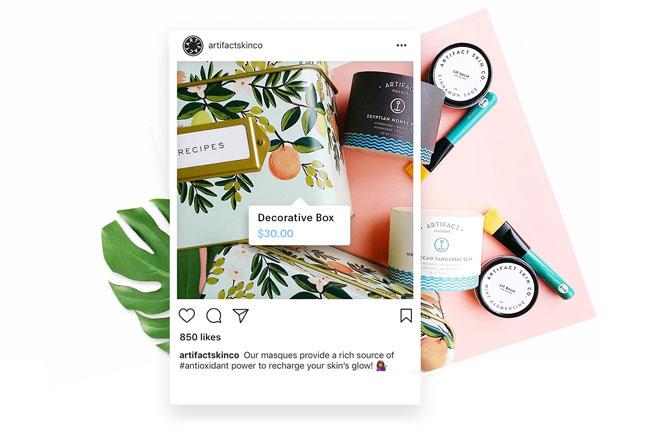Turn your Instagram followers into buyers with Instagram shoppable tags. Officially the hottest social media trend for online sellers right now, especially brands with highly visual products. This new feature opens up a new world of opportunity on the world’s leading visually-focused social platform.
A BigCommerce case study on early adopters of the new feature uncovered big numbers. One fashion brand reported a 1,416% increase in Instagram traffic. While another reported a 20% boost in revenue.
We don’t want you to miss out on such a massive opportunity to boost online sales to new heights, especially when you can do it with images. Here’s our guide to getting started with Instagram shoppable tags.
The basics of Instagram shoppable tags
How does it work?
There’s no augmented reality trickery or super fiddly photo shoot setup that you need to master to create easily shoppable posts.
All you need to do is link your Instagram business profile to a Facebook product catalog (more on that below), which you can also connect to your Shopify or BigCommerce store.

Source: Shopify
So instead of just having a single link in your bio and using a post to point followers to it, you can allow them to click straight through to the product pages that you’ve tagged in the image.
How can you start using shoppable tags for your store? We thought you’d never ask.
First, you’ve got to be approved
Not everyone can take advantage of shoppable posts. The program is still pretty new right now, and as of this post, it’s limited. Some restrictions are likely to stay in place long-term because Instagram will want to protect their image. Preventing any negative associations from products sold on the platform.
As of right now, this is how you get in to be able to sell directly from your Instagram posts:
- First, you have to be located in one the following countries: USA, United Kingdom, Australia, Canada, France, Germany, Italy, Spain or Brazil.
- Make sure your Instagram account is switched to a business profile.
- You have to have a Facebook Product Catalog, and it must be connected to your Instagram profile. Shopify and BigCommerce users can do this more efficiently and directly.
- You must be selling physical products and nothing that conflicts with Facebook’s Commerce Policies.
- Once you have all that taken care of, you can apply to sell on Instagram.
Most people are approved within a few days, although some shops that require further review might take a bit longer.
Next, create your Instagram shoppable tags
Once you are connected, you can tag up to 5 products in a single image, or 20 products in a multi-image. You’ll add all the information to the tag, and then apply them to new or existing posts.
For each tag, you’ll need:
- Product name
- Price
- URL for the product page
If you use Google Analytics, make sure you track your marketing campaigns, remember to create a UTM code. Tracking your efforts will give you more insight on how effective your Instagram posts are and how you can get the most out of this traffic.

Source: Social Media Examiner
The process of adding Instagram shoppable tags to your posts is pretty intuitive:
- Grab the image you want to tag, and start to upload just like a regular post.
- Press “Tag Products”
- You’ll see a screen where you can tap a spot to indicate a product.
- A second screen will appear, and you identify the product from your Facebook product catalog.
- Repeat up to 5 times for a single image, or 20 for multi-image posts.
A few things to keep in mind with the Instagram shoppable tags:
- The language and currency for your tagged products are inherited from your Facebook product catalog. Make sure they match up to your audience. You can find out more about your audience through Insights as a part of your business profile.
- If a product goes out of stock in your Facebook catalog, the tag for that item will disappear from any images you placed it on. Currently, it will not automatically return when it comes back into stock.
- Switching the Facebook product catalog you use will not delete the tags. The tags will remain in place, but aren’t connected to your store.
- You can’t tag products and other accounts in the same post.
- Tags don’t show up on Instagram used through a browser, only in the app. All traffic will be mobile. Make sure your site is mobile-optimized.
How can you use shoppable tags as part of your Instagram strategy?
Source: TechCrunch
If you are in a position to make good use of shoppable tags, you a probably already have a solid social media strategy plan in place and have a healthy Instagram following. Stay true to your audience and the strategy that brought you success to start with.
Do
- Keep posting non-shoppable, connection building posts that your audience will love.
- Make sure your shoppable post pictures are the same high-quality as your on-site product pictures and mainline Instagram content.
- Follow up with insights and analytics to make sure you are promoting successful products and testing new ideas for your shoppable posts.
- Use collections and multi-image posts to show off groups of products that go well together and appeal to a specific customer profile. If you know that specific items are often purchased together in your store, put them together in a tagged post.
- Use natural collections such as matching outfits or furniture and decor that lend a specific, unified feel to a room.
Don’t
- Treat your Instagram account like a giant wall of sales. Instead, keep posting quality content and adding value to your followers’ daily lives.
- Cram too much into each tagged image. You can tag up to 5, but that will only work for some product types and collections.
- Throw every product on a shoppable post as soon as you can. Take your time, see what works for your store.
Start tagging
Instagram shoppable tags are not something you should put off. These are set to be a game-changer, so if Instagram is part of your marketing strategy, you should put this into place as soon as possible. Start your approval process today, and turn your Instagram followers into buyers. You could see a significant boost in revenue without spending more on your traffic.









